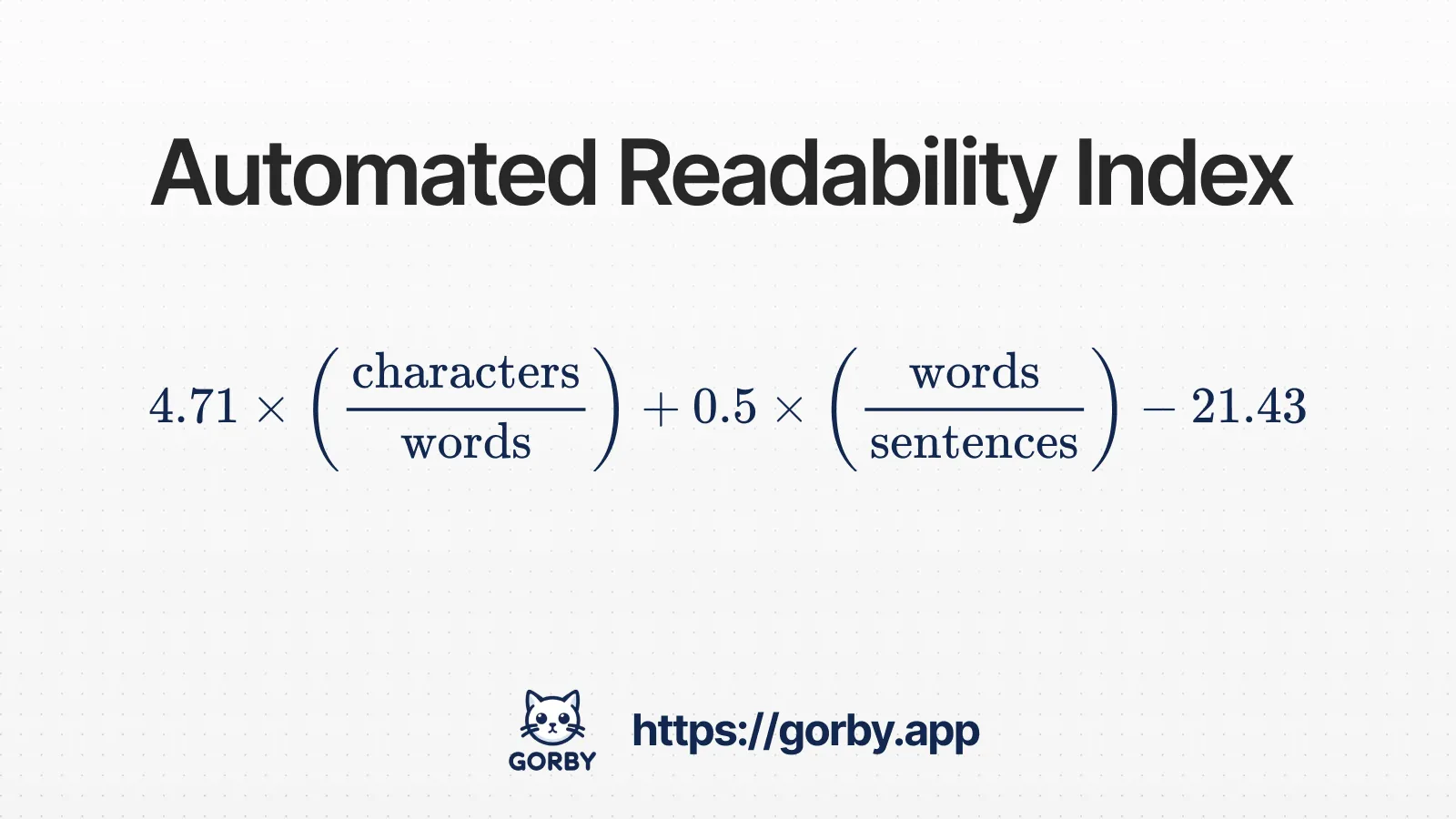Automated Readability Index Calculator
Instantly measure your text's grade level and accessibility using the Automated Readability Index (ARI). Unlike other readability formulas, ARI provides rapid, accurate assessments by analyzing character and sentence structures, making it particularly effective for technical and professional content.
Understanding the Automated Readability Index
What is the Automated Readability Index?
The Automated Readability Index (ARI) is a mathematical formula that assesses the grade-level readability of English text. Developed in 1967 for the U.S. Air Force, it revolutionized readability assessment by focusing on character count rather than syllables, enabling faster and more automated analysis.
Unlike traditional readability metrics, ARI evaluates text complexity based on characters per word and words per sentence, making it particularly suitable for technical documentation and professional writing where precision is crucial.
Origins and Development
The ARI emerged from a critical need in military communications, where clear, accessible documentation was essential for personnel training and safety. Initially designed for use with electronic typewriters, it was among the first readability metrics specifically created for real-time automated assessment.
This innovative approach solved a significant challenge in the 1960s: how to quickly evaluate and improve technical documentation for military personnel from diverse educational backgrounds. The success of ARI in military applications led to its widespread adoption in technical writing, education, and professional communication.
How ARI Stands Apart
What makes ARI unique is its character-based approach. While other formulas like Flesch-Kincaid rely on counting syllables, a process that can be inconsistent and challenging to automate, ARI's focus on character count provides several advantages:
- More consistent measurements across different texts
- Faster computational processing
- Better suitability for technical and specialized content
- Easier integration with modern writing tools
Modern Applications
Today, ARI continues to be valuable across various fields. It's particularly useful in technical documentation, educational material development, and professional communication where precise readability assessment is crucial. The simplicity and reliability of ARI make it an excellent choice for both individual writers and organizations aiming to maintain consistent content accessibility standards.
The Automated Readability Index Formula Explained

Understanding the Components
The ARI formula combines two key text measurements with carefully calibrated weights to determine reading difficulty. Let's break down each component:
Characters per Word
The first part of the formula (4.71 × characters ÷ words) measures word complexity by looking at average character length. Longer words typically indicate more complex vocabulary. The 4.71 multiplier gives appropriate weight to this factor.
Words per Sentence
The second part (0.5 × words ÷ sentences) evaluates sentence complexity through length. Longer sentences often contain more complex ideas or multiple concepts. The 0.5 multiplier balances this factor's influence on the final score.
Adjustment Constant
The subtraction of 21.43 adjusts the raw score to align with U.S. grade levels. This calibration ensures the final score corresponds meaningfully to education levels.
Important Calculation Notes
- Characters include letters, numbers, but not spaces
- Sentences are determined by terminal punctuation marks (., !, ?)
Quick Example
Consider this passage: "The mysterious scientist conducted groundbreaking experiments in the laboratory. Her research revolutionized the field."
- Characters: 104 (excluding spaces)
- Words: 14
- Sentences: 2
- Characters per word: 7.43
- Words per sentence: 7
- Final ARI score: 17.06
This passage scores at a college student reading level, which makes sense given its academic vocabulary ("mysterious," "conducted," "groundbreaking," "revolutionized") and scientific context.
ARI Grade Level Scale
The ARI score directly corresponds to the U.S. education grade level required to comprehend the text. Here's a comprehensive breakdown of scores and their interpretations.
| ARI Score | Grade Level | Reader Age |
|---|---|---|
| 14+ | College student | 18-22 |
| 13 | Twelfth Grade | 17-18 |
| 12 | Eleventh Grade | 16-17 |
| 11 | Tenth Grade | 15-16 |
| 10 | Ninth Grade | 14-15 |
| 9 | Eighth Grade | 13-14 |
| 8 | Seventh Grade | 12-13 |
| 7 | Sixth Grade | 11-12 |
| 6 | Fifth Grade | 10-11 |
| 5 | Fourth Grade | 9-10 |
| 4 | Third Grade | 8-9 |
| 3 | Second Grade | 7-8 |
| 2 | First Grade | 6-7 |
| 1 or less | Kindergarten | 5-6 |
Interpreting ARI Scores
The ideal ARI score depends entirely on your target audience. While lower scores generally indicate better readability, some content requires higher complexity. Here's what you should know:
General Audience Content
Aim for scores between 8-9 (7th-8th grade level). This range is accessible to most readers while maintaining professional credibility.
Technical Documentation
Scores between 11-13 are acceptable, reflecting the complex nature of technical subjects while still maintaining clarity.
Academic Writing
Scores of 14+ are common and often necessary, reflecting the sophisticated concepts and vocabulary required for college-level content.
Marketing Content
Aim for scores between 7-8 (6th-7th grade level) to ensure your message reaches the widest possible audience without seeming oversimplified.
📝 Pro Tip
When in doubt, remember that the average adult in the United States reads at approximately an 8th-grade level (ARI score of 9). Unless your content specifically requires higher complexity, aiming for this level ensures maximum accessibility while maintaining professional standards.
Automated Readability Index vs other readability metrics
While several readability formulas exist, ARI offers unique advantages for specific use cases. Here's how it compares to other popular metrics:
Flesch-Kincaid
Uses syllable count instead of character count. While accurate, syllable counting can be inconsistent and slower to process computationally compared to ARI's character-based approach.
Coleman-Liau
Similar to ARI in using character count, but with different weighting factors. Generally produces similar results to ARI but may be less accurate for technical content.
SMOG Index
Focuses on polysyllabic words, making it particularly suitable for healthcare materials. However, it's less efficient for automated processing compared to ARI.
Tips to Improve Your ARI Score
Sentence Structure
- • Keep sentences under 20 words when possible
- • Vary sentence length for better flow
- • Break complex sentences into smaller ones
Word Choice
- • Use shorter, familiar words
- • Replace complex terms with simpler alternatives
- • Avoid unnecessary technical jargon
Content Structure
- • Use clear paragraph breaks
- • Start with the most important information
- • Use bullet points for complex lists
Revision Process
- • Check ARI score regularly while writing
- • Read content aloud to identify complex passages
- • Get feedback from your target audience
Remember: The goal isn't always to achieve the lowest possible ARI score. Instead, aim for a score that matches your target audience's reading level while maintaining the accuracy and professionalism your content requires.
Ready to Analyze Your Text?
Get instant readability insights with Gorby's text analysis tools.
Try our text analyzer to see all readability scores, including ARI, in one place. Check word counts, readability metrics, and get writing suggestions instantly.
Resources and References
Automated Readability Index
Wikipedia article providing a comprehensive overview of ARI's history, formula, and applications.
Original ARI Research Paper (1967)
Senter, R.J.; Smith, E.A. "Automated Readability Index" - The foundational research paper from Wright-Patterson Air Force Base.
Derivation Of New Readability Formulas
Research paper comparing ARI with other readability metrics for Navy enlisted personnel.
Literacy Project Foundation
Current statistics and information about literacy rates and reading levels.
More Readability Tools
All Readability Metrics
Overview of all readability formulas and tools
Coleman-Liau Index
Analyze text complexity using characters per word
Dale-Chall Readability
Evaluate readability using word familiarity
Flesch Reading Ease
Measure text readability on a 100-point scale
Flesch-Kincaid Grade Level
Convert text complexity to U.S. grade levels
Gunning Fog Index
Measure text complexity using sentence length and word difficulty
SMOG Index
Assess readability based on polysyllabic words
Spache Readability Formula
Evaluate early reading materials using familiar word lists
